HTC One M9 vs HTC One M8: Should you upgrade?

HTC One M9 or One M8? We’ve lived with both to help you decide if you need to make the upgrade from the M8 or the One M7
We’ve given our verdict on the One M9 and while it’s an evolution rather than a smartphone revolution, it’s still a solid, good-looking HTC flagship. If you’re currently in the possession of the One M8 or even the One M7, and set against going for the Galaxy S6, the Galaxy S6 Edge or the iPhone 6, you’re probably weighing up whether you should make the jump to the latest top-of-the-range HTC.
We’ve been living with both the M9 and M8 in our pockets over the past couple of weeks to help make that decision to stick or twist a little easier. From the re-jigged design to the bigger battery, here’s where we think the One M9 excels and what it lacks in comparison to its predecessor.
Watch our HTC One M9 hands-on video
HTC One M9 vs One M8 – Design
One M9: 9.6mm thick, 157g, aluminium, two-tone finish, Gunmetal Grey, Amber Gold, Silver/Rose Gold, Gold/Pink
One M8: 9.4mm thick, 160g, aluminium, Gunmetal Gray, Glacial Silver, Amber Gold
The One M8 is arguably one of the best-looking flagship phones we’ve had the pleasure of using. There are few phones that could rival its sleek, aluminium unibody design. So how do you improve on a metal phone that looks so great? Well, when you put them side by side you can see how much of a challenge it was for HTC.
From the front, it’s much the same. There’s the two front-firing speakers and the identical 5-inch screens, with slim black bezels around them. The most noticeable change here is the upgraded camera sensor. HTC has moved the Ultrapixel camera with its dual lenses from the back of the phone to the front.
Related: Best Mobile Deals: Top Smartphone offers this month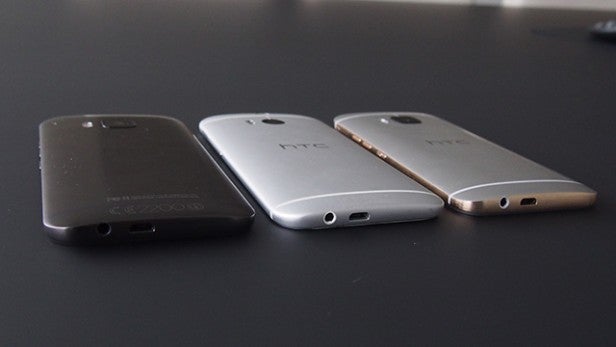
Left to Right: Gunmetal One M9, Silver One M8 and Silver/Rose gold One M9
It’s when you get both phones in your hand that you can begin to appreciate the differences in design. The One M9 is the slightly thicker of the two and that’s down to the new two-tone metal trim. HTC has essentially given the One M9 a metal casing that covers the back and sides of the phone. What this creates is a lip between the silver metal finish and the rose gold layer on top. It doesn’t improve the aesthetics in a good way in our opinion and all feels a bit fussy.
HTC does a better job in the gunmetal grey model, where the two-tone finish isn’t as prominent. Another issue is the way it feels to hold. Your fingers rest in between the two metal layers and it simply doesn’t feel as nice to grip as the One M8. It’s almost as if HTC has played with the design to make it feel different when it didn’t need to.
There’s changes in the back as well. While you still get the gently curved back with antenna lines on the bottom and top of the phone, the feel of the metal has entirely changed. It’s still the cool aluminium we loved on the M8 except it has a less glossy and more textured feel to aid gripping. We certainly didn’t have any problems with the One M8 in that respect but it doesn’t slip and slide in your hand like the Xperia Z3.
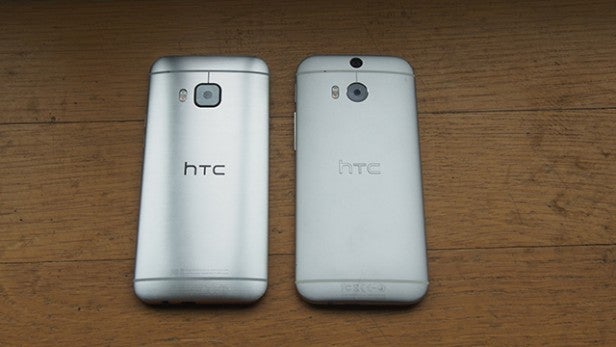
One M8 (left) next to the One M9 (right)
You’ll also spot that the camera outlay has changed with a larger 20-megapixel sensor alongside the same dual LED flash from the One M8 now in place of the Ultrapixel setup. Now it is closer in shape and look to the square sensor on the S5 except it’s bigger than Samsung’s 16-megapixel sensor and far less protruding.
HTC has also made some interesting decisions with button placement. The headphone jack and the micro USB port stays put so there’s nothing new there. On the left edge, the micro SD card support has been replaced with the nano-SIM card slot. That micro SD card slot has moved over to the right edge alongside a volume rocker that’s now separated and the standby button below, which sits halfway down the phone’s side. While that does mean it’s easier to turn the phone on and off, it’s close proximity with the volume keys makes it all too easy to mix it up with the volume keys.
If you had to ask us which we prefer, we’d actually say the One M8. The changes HTC has made don’t seem all positive. It’s still one of the most attractive phones you can lay your hands on but is is that much better than the One M8? We’d be inclined to say no.
HTC One M9 vs One M8 – Screen
One M9: 5-inch, Full HD 1080p Super LCD screen with 441 ppi, Gorilla Glass 4
One M8: 5-inch, Full HD 1080p Super LCD screen with 441 pip, Gorilla Glass 3
Despite the current trend for the likes of Samsung and LG to use ‘2K’ QHD resolution displays, HTC is sticking to its guns by using the very same 5-inch screen used on the One M8. They are identical albeit for the Gorilla Glass 4 coating on the One M9, which adds the latest generation of scratch resistant protection.
Samsung’s QHD displays have certainly impressed especially on the Note 4, but for most, a Full HD screen is more than suitable. The 1,920 x 1,080 resolution against the 2,560 x 1,440 on the Note 4 or the LG G3 is a big difference but this is still one of the best phones for sharpness, vibrancy and viewing angles.
SEE ALSO: Samsung Galaxy S6 vs HTC One M9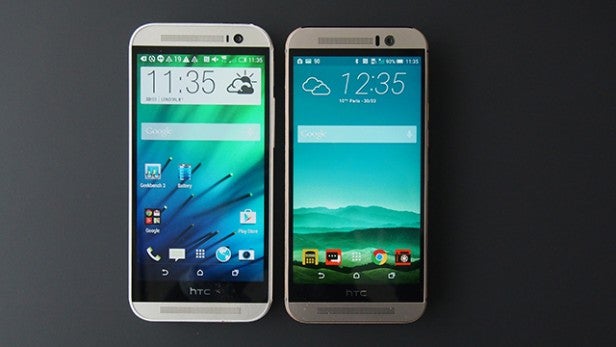
Where the One M9 does make a slightly distinguishing improvement is brightness. The One M9 manages 508 nits in comparison to the M8’s 490 nits and it does show when cranked up to full brightness. Again, it’s not a big enough of a difference to alter the viewing experience in daylight and at night.
While the One M9 shades it for brightness, there’s next to nothing separating these two for screen quality. Even the One M7’s Full HD screen makes a strong showing.
HTC One M9 vs One M8 – Software
One M9: Android 5.0 Lollipop with Sense UI 7.0
One M8: Android 4.4.2 KitKat/Android 5.0 Lollipop with Sense UI 6.0
HTC’s Sense Ui is one of the more attractive approaches to Android, especially when compared to what Samsung and Sony offers. So it’s no surprise to see that the One M9 doesn’t make any truly radical changes. You’ll still find Blinkeed to give you updates from selected websites and social networks. The horizontal scrolling app drawer is still in place and there’s isn’t a significant amount of changes made in the Settings menu. New additions include a revamped photo editor, the ability to customise the navigation bar and the Sense Home widget.
SEE ALSO: HTC One M9 Sense 7.0 Features explored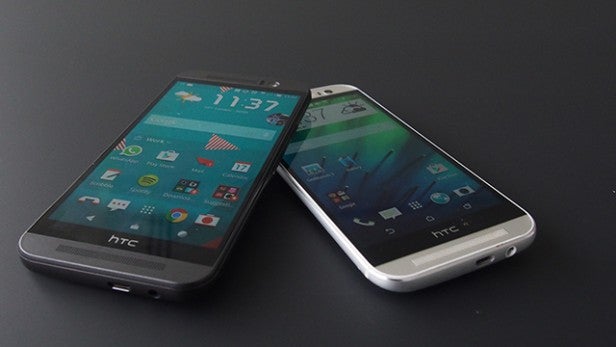
What really separates the two versions of Sense is something called Themes. This is essentially a way of personalising and customising the UI. It sounds very similar to what Huawei has been offering on its handsets for a while now, albeit with more stylised choices. You can adjust wallpapers, app icons, sounds and even fonts with HTC’s own themes or use one of your photos to create more personal themes. Making those changes won’t cost you any extra money and while it’s a nice way to make your UI feel more unique, it’s not a really a phone-selling feature.
HTC has already confirmed that the One M8 will also get the Sense 7.0 UI treatment, which means it’s yet another feature you are not going to miss out if you opt against upgrading to the One M9.
HTC One M9 vs One M8 – Performance
One M9: Snapdragon 810, quad-core 1.5GHZ Cortex-A53 and 2GHZ Cortex-A57 with 3GB RAM and Adreno 430 GPU
One M8: Snapdragon 801, quad-core 2.3GHZ, Motion co-processor with 2GB RAM and Adreno 330 GPU
Another year, another generational leap in processor power. The HTC One M8 and M9 use Snapdragon processors from Qualcomm, but there’s quite a gap in power between the Snapdragon 801 of the One M8 and the Snapdragon 810 of the M9.
The HTC One M8 has four 2.3GHz Krait cores plus an Adreno 330 GPU and a motion co-processor to handle data from the phone’s numerous sensors. with the One M9, you get eight cores. You get four 2GHz Cortex-A57 performance cores plus four lower-power 1.5GHz Cortex-A53 ones. Clock speed is a bit lower, but performance is way up.
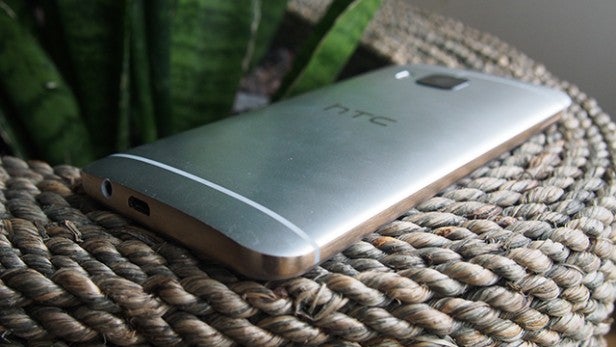
The One M9’s Adreno 430 GPU is also a good deal beefier. The Snapdragon 810 is the first 64-bit flagship mobile processor in the range, which could prove to be an important part of this year’s phone future-proofing. Android 5.0 Lollipop now has native support for 64-bit processors, and most of this years phones are likely to have a 64-bit processor architecture.
Using the Geekbench 3 benchmarking test, the One M8 scores 2,840 points in the multi-core test, while the One M9 manages on average around the 4,000 point score.
What that tells us is that there’s a significant jump in power.
In day-to-day use, both phone are still well equipped. General navigation is still smooth and gaming still impresses. While the One M8 is certainly not past it, it’s not cutting edge anymore either.
HTC One M9 vs HTC One M8 – Storage
HTC One M9 Storage: 32GB with microSD
HTC One M8 Storage: 16GB with microSD (32GB available)
The very first HTC One didn’t have a microSD memory card slot, but thankfully both the HTC One M8 and M9 do.
There are 16GB and 32GB models of the HTC One M8, but the one you see on sale most often is the 16GB model. This year’s One M9 gets the upgrade to 32GB, giving you that extra bit of buffer. Most people probably won’t even need to get hold of a microSD card.
Each model supports the SDXC format, meaning big media fans can use 128GB cards without any problems. They still don’t come cheap, mind: £60-70 at the moment.
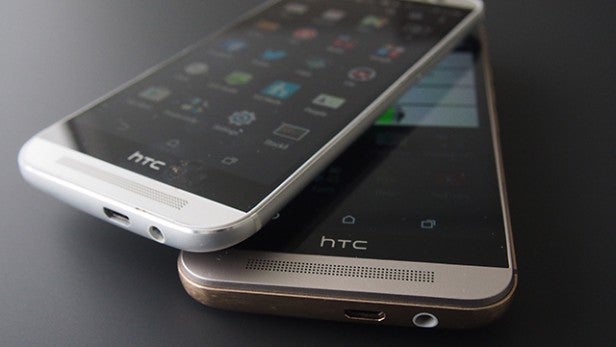
HTC One M9 vs One M8 – Speakers
One M9: Boomsound front-facing speakers with surround DSP
One M8: Boomsound front-facing speakers
The HTC One M8 and One M9 have some of the best speakers seen in a phone. HTC calls them BoomSound speakers, and they sit above and below the screen to get you a pretty much perfect stereo image when you’re watching movies. Plus, you don’t need to worry about covering them and muffling the sound.
While the driver hardware seems to be similar or the same, the One M9 also features some new Dolby surround DSP to make the most of those plucky little speakers. Dolby’s digital signal processing uses clever software changes to make the soundstage appear much larger. There’s now specific Boomsound profiles letting you switch between music modes and theatre modes depending on what you’re listening to.
The One M8 sounds as good as the One M9 in our view whether you are listening out loud or with the bundled in-ears plugged in. Some might appreciate the nuances in the slightly wider soundstage but there’s little to separate the two setups.
SEE ALSO: Android 5.0 Lollipop Tips and Tricks 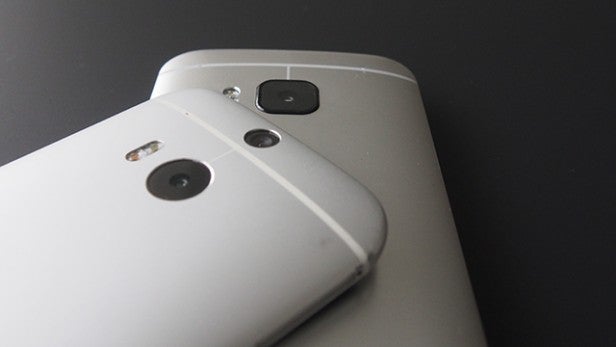
HTC One M9 vs One M8 – Camera
One M9: 20.7-megapixel main camera with dual LED flash, 4-megapixel Ultrapixel camera
One M8: 4-megapixel Ultrapixel main camera with dual LED flash, 5-megapixel front-facing camera
The UltraPixel dream is (mostly) over. In 2013 HTC came up with the idea of the UltraPixel camera. The HTC One and One M8 both use a low-res 4-megapixel main sensor, but those pixels are a lot larger than the ones found in other flagship smartphones. This gets you better low-light performance, but there’s nothing like the detail you get with a higher-res sensor.
In the One M9 the UltraPixel camera has been relegated from lead position on the back, moved to the front. Yep, the M9 gets you UltraPixel selfies. The HTC One M8 has a 5-megapixel front camera: higher resolution, but likely to offer worse results in most conditions as the sensor is smaller. Playing around with the front-facing camera in comparison to the One M8 you can clearly see improvements but you still have to contend with some of the same struggles with image noise and sharpness. The One M9’s ability to generate brigher more natural images certainly shows in the image example below.

Non-smiling selfie comparison: One M8 (left) vs One M9 (right)
HTC has rejoined the pack in using a more conventional high-res sensor for the main camera. The HTC One M9 has a 20-megapixel rear camera to get some detailed photos out of an HTC flagship phone. You’ll also notice that where the HTC One M8 has two rear lenses, the One M9 has only one. As well as dropping the UltraPixel ideal for the back camera, there’s no longer 3D-sensing hardware.
The HTC One M8 uses two sensors and lenses to let the phone tell between near and far objects, letting you blur out backgrounds and perform other such effects. Realising this was a bit of a gimmick in the first place, HTC has decided to use a special mode and just the one lens to do this going forwards, just like every other phone-maker.
While results are inevitably better than what the One M8 is capable of, it’s still lacks in comparison to the S6 Edge and even the S5 cameras as explained in our One M9 camera comparison. In well lit conditions you can get some good results, but problems still persist in low-light as the images below illustrates.
One M9 vs One M8 landscape, good lighting samples
In good lighting, neither really excel for vibrancy. The One edges it for brightness especially on the buildings , but the One M9 picks out more detail and colours are far more accurate. We’d say the One M9 wins this camera battle. Just.
One M9
One M8
One M9 vs One M8 close-up indoors samples
Again, there’s very little between the two, but on closer inspection, there’s more detail in the One M9 image in comparison to the One M8 image. Colours are again more vibrant and colourful but there’s still some noticeable image noise in both samples.
One M9
One M8
One M9 vs One M8: Low-light landscape
This is one of the most disappointing elements of both cameras. The One M8 produces the brighter image but there’s heavy amount of image noise present. The One M9’s camera struggles to brighten up the image and is a very blurry mess. The light bleed is clearly also an issue here. We’d say these two cameras match for mediocrity.
One M9
One M8
One M9 vs One M8: Low-light indoors samples
When you take the phones indoors both have the advantages of using dual LED flashes to brighten up surroundings and objects significantly. The One M8 image looks a little more balanced for colour accuracy and image sharpness. The M9’s white balance impresses and you do get a little more in the way of detail. Again, wed’ say the cameras are level-pegged.
One M9
One M8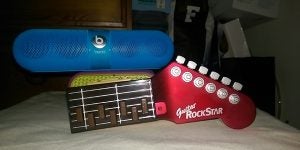
When you need to take video the One M9 can deliver the higher resolution footage but with restrictions. Like the S5 and the G Flex 2, you can shoot 4K video but you can shoot a maximum of six minutes footage. Other than that, the two are identical. You can shoot 1080p HD at 60fps or 720p HD at 120fps. There’s HDR modes and slow-motion video support plus Zoe mode.
We shot some sample video in Full HD and as you can see, there’s very little difference. 4K shooting is what separates the two and if you truly a value feature that requires the necessary 4K hardware to truly appreciate your shooting on a big scale, then this is another place where the two phone effectively tie.
If we had to pick a camera, we’d say either gives you good but not fantastic results. If you value selfies, then the One M9 is the one to get, otherwise you’re stuck with two very decent but far from class-leading shooters.
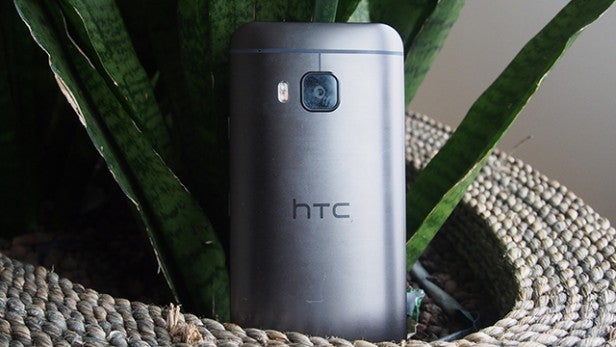
HTC One M9 vs One M8 – Battery
One M9: 2,840mAh non-removable with Quick Charge 2.0 technology
One M8: 2,600mAh non removable with Quick Charge 2.0 technology
As the HTC One M9 doesn’t increase screen size or resolution, it doesn’t need to massively increase battery life, but it does get a small-but-significant upgrade. The HTC One M8 has a 2,600mAh battery while the M9 uses a 2,840mAh one. A quick bit of maths tells you that’s an extra 240mAh. You can’t get access to either battery, as they’re firmly held in place behind the non-removable aluminium back.
In more intense testing, the One M9 manages around the ten hours as the One M8 does. It’s the day to day use, it’s an entirely different story. With medium usage, the One M8 has the capability to pack in two days, the One M9 suffers a bigger drain and will get you more comfortably through the day. It’s not really clear why there’s such a disparity in battery performance, especially when the One M9 packs a bigger battery but it’s something we are continuing to explore.
You do have the benefit of the power saver mode on both, which restricts some functions to keep the battery going longer. Quick Charge 2.0 supports means with the supplied charger, you can power up to near 60% of the battery power in under thirty minutes.
SEE ALSO: Samsung Galaxy S6 vs Galaxy S6 Edge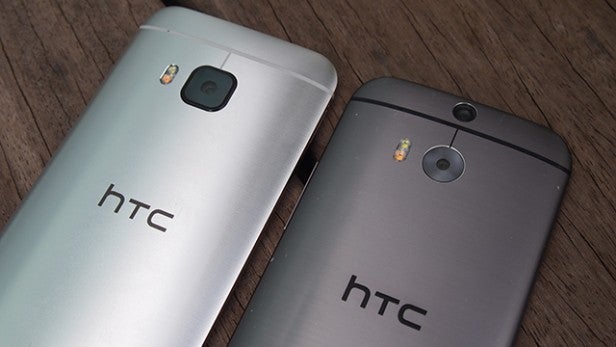
The Verdict
We’ve spent just over a week living with the One M8 and the One M9 and we’d have to say that the One M9 just doesn’t feel enough of an upgrade. The main benefits lie with the camera and the increase in performance although as explained, you’re not missing out on anything ground-breaking. Elsewhere it’s business as usual. Some of the design changes were not needed, the screen is the same quality and for some reason the battery doesn’t make as strong a showing as its predecessor.
When you compare prices, you can grab the One M8 on a contract from Three as cheap as £28 a month where the One M9 can cost £39 and upwards. SIM-free from Expansys, a 32GB One M9 costs £579 in comparison to the £365 you need to pay for a 16GB One M8. While you lose out on the storage, we don’t think you really lose out on the features.
If you own the One M7, then it might be a slightly different proposition, but then again, going for the One M8 is still a worthwhile and more affordable option. You’ll have to live with a far from class-leading camera and not so cutting-edge processor setup, but it’s still a great phone with a beautiful design.
The changes we’ve seen with the One M9 tells us that there’s no reason to be too hasty about upgrading. That might change though when the new HTC One turns up.
Thanks to Three for providing us with the HTC One M8 used in this article


